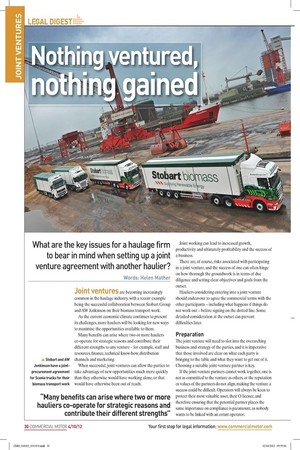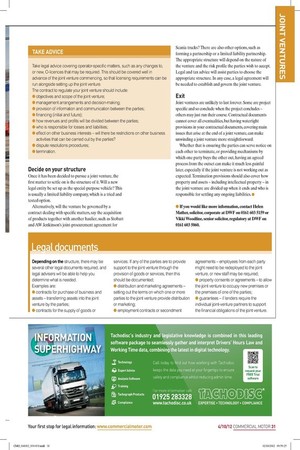Nothing ventured,
Page 22

Page 23

If you've noticed an error in this article please click here to report it so we can fix it.
nothing gained
What are the key issues for a haulage firm to bear in mind when setting up a joint venture agreement with another haulier?
Words: Helen Mather
Joint ventures are becoming increasingly common in the haulage industry, with a recent example being the successful collaboration between Stobart Group and AW Jenkinson on their biomass transport work.
As the current economic climate continues to present its challenges, more hauliers will be looking for new ways to maximise the opportunities available to them.
Many benefits can arise where two or more hauliers co-operate for strategic reasons and contribute their different strengths to any venture – for example, staff and resources, finance, technical know-how, distribution channels and marketing.
When successful, joint ventures can allow the parties to take advantage of new opportunities much more quickly than they otherwise would have working alone, or that would have otherwise been out of reach. Joint working can lead to increased growth, productivity and ultimately profitability and the success of a business.
There are, of course, risks associated with participating in a joint venture, and the success of one can often hinge on how thorough the groundwork is in terms of due diligence and setting clear objectives and goals from the outset.
Hauliers considering entering into a joint venture should endeavour to agree the commercial terms with the other participants – including what happens if things do not work out – before signing on the dotted line. Some detailed consideration at the outset can prevent difficulties later.
Preparation
The joint venture will need to slot into the overarching business and strategy of the parties, and it is imperative that those involved are clear on what each party is bringing to the table and what they want to get out of it. Choosing a suitable joint-venture partner is key.
If the joint-venture partners cannot work together, one is not as committed to the venture as others, or the reputation or values of the partners do not align, making the venture a success could be difficult. Operators will always be keen to protect their most valuable asset, their O-licence, and therefore ensuring that the potential partner places the same importance on compliance is paramount, as nobody wants to be linked with an errant operator.
Decide on your structure
Once it has been decided to pursue a joint venture, the first matter to settle on is the structure of it. Will a new legal entity be set up as the special-purpose vehicle? This is usually a limited liability company, which is a tried and tested option.
Alternatively, will the venture be governed by a contract dealing with specific matters, say the acquisition of products together with another haulier, such as Stobart and AW Jenkinson’s joint-procurement agreement for Scania trucks? There are also other options, such as forming a partnership or a limited liability partnership. The appropriate structure will depend on the nature of the venture and the risk profile the parties wish to accept. Legal and tax advice will assist parties to choose the appropriate structure. In any case, a legal agreement will be needed to establish and govern the joint venture.
Exit
Joint ventures are unlikely to last forever. Some are project specific and so conclude when the project concludes – others may just run their course. Contractual documents cannot cover all eventualities, but having watertight provisions in your contractual documents, covering main issues that arise at the end of a joint venture, can make unwinding a joint venture more straightforward.
Whether that is ensuring the parties can serve notice on each other to terminate, or providing mechanisms by which one party buys the other out, having an agreed process from the outset can make it much less painful later, especially if the joint venture is not working out as expected. Termination provisions should also cover how property and assets – including intellectual property – in the joint venture are divided up when it ends and who is responsible for settling any ongoing liabilities. ■ • If you would like more information, contact Helen Mather, solicitor, corporate at DWF on 0161 603 5159 or Vikki Woodfine, senior solicitor, regulatory at DWF on 0161 603 5060.










































